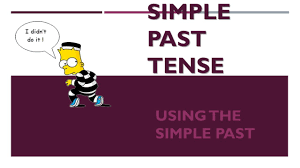The sentence formation follows:
| Singular Number | Plural Number | |
| 1st Person | I did | We did |
| 2nd Person | You did | You did |
| 3rd Person | He did | |
| She did | They did | |
| It did |
Uses of The Simple Past Tense:
- The past
tense refers to actions completed in the past at a definite time:
- Actions with the specific time given: We met them to discuss this proposal yesterday. His father passed away in 2016. I was born in 1990.
- When actions took place even though time is not mentioned: The bus arrived 10 minutes late. How did you convince him to work with you? I bought a Volvo S90 car in Canada.
- The past tense is used for a past habit: She always
carried a water bottle. My father
drank the cold milk.
- We can also use ‘used to’ or ‘would’ for past habitual actions: My father used to drink cold milk. My father would drink cold milk.
- The past tense is also used in conditional sentences when the supposition is contrary to known facts: If I were you, I would not have done such a mistake (But I am not you.)
Note: The same sentence can also be constructed in other way as well: Were I you, I would not have done such a mistake (But I am not you.)
If I knew this fact beforehand, I would not have permitted him to go and talk to him. (But I don’t know this fact.)
For the unreal past, we use subjunctive mood with as though, as if, it is time, if only, would sooner/rather and wish.
She is crying as if she were a child. (But she is not a child)
- The past tense is used for describing incidents/accidents: The plane was hijacked by terrorists. Two pilots were killed in a helicopter crash.
- The past tense is used for narrating stories and history: Maharaja Ranjit Singh was a brave king. There was a clever crow. The 1897 battle of Saragarhi was the epitome of bravery, sacrifice and valor. Baji Rao never lost a battle in his life.
